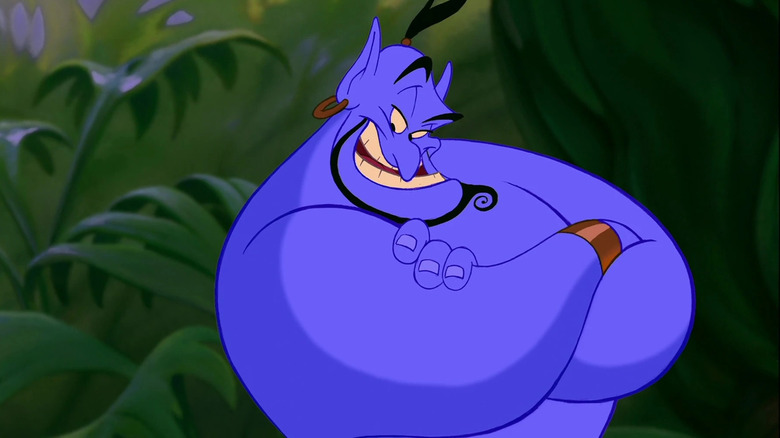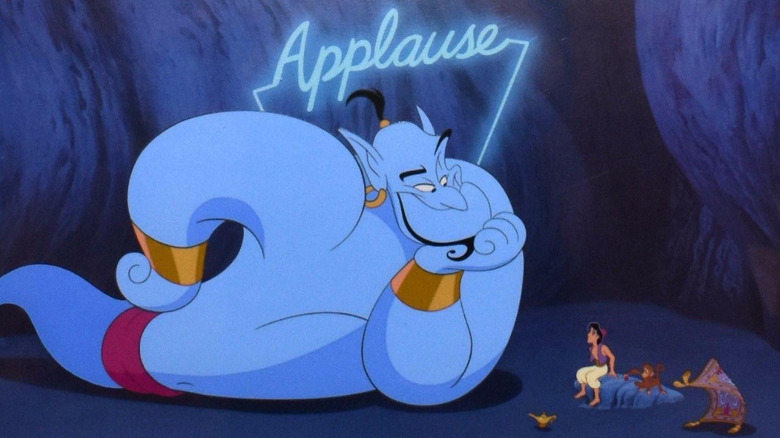Robin Williams' Aladdin Casting Called For A Complete Reimagining Of The Genie Role
"Aladdin" rode the crest of a powerful creative wave for Walt Disney Animation Studios upon its release in 1992. The musical fantasy was the studio's 31st motion picture and emerged within a renaissance of highly acclaimed animated tales like "Beauty and the Beast," following a decade of poorly-performing animated features. Its story is ostensibly about a street kid who finds a magic lamp, but it's the wild magic-man in the lamp, voiced by the late comedian Robin Williams, who remains the most recognizable character of the whole thing, serving up quick-fire zingers and impersonations of everyone from Peter Lorre to Jack Nicholson.
Dave Itzkoff shares insights on the "Awakenings" star in his 2018 biography "Robin," detailing the creative process behind the role of the genie when Williams joined the "Aladdin" team. While Jeffrey Katzenberg envisioned a swashbuckling historical fantasy like "The Thief of Baghdad," co-directors Ron Clements and John Musker (with encouragement from lead composer Alan Menken) convinced the studio chairman to embrace a cozier retelling of the Arabic folktale.
The phenomenal cosmic powered Genie is one of the story's most essential characters from the moment he emerges from oil lamp captivity. The original vision for him: a charming Jazz Age-inspired entertainer, who Menken described as "a hipster, à la Fats Waller and Cab Calloway." This genie was Black and had an earring.
But Katzenberg, having recently seen Williams' quick wit in Touchstone Pictures' "Good Morning, Vietnam," thought the big name comedian would be perfect for the role — an uncommon approach in feature animation casting at the time. Though Itzkoff's biography notes that Williams' casting was never in dispute, it's clear that the real catalyst came when the leading man of "Hook" met with animators and saw test footage of the big blue wish-granting buddy.
A new fantastic point of view
Robin WIlliams' casting as the Genie marked a lean into high-profile actors for animated voice over roles, rather than using traditionally trained voice actors. But it wasn't any old audition process — Williams, by now, commanded an $8 million fee — as much as it was a hurried screening. As Itzkof's book explains, Disney animator Eric Goldberg was assigned to create some test footage, which he did using vocal tracks from Robin's stand-up comedy albums. Shown this footage and some storyboards for the musical numbers like the showstopping "Friend Like Me," Williams reportedly belly-laughed and the deal was sealed like the Cave of Wonders. In "Robin," Goldberg elaborates on the stand-up audio he worked with:
"I think what probably sold him was the one where he says, 'Tonight, let's talk about the serious subject of schizophrenia—No, it doesn't!—Shut up, let him talk!' What I did is animate the Genie growing another head to argue with himself, and Robin just laughed. He could see the potential of what the character could be. I'm sure it wasn't the only factor, but then he signed the dotted line."
The following March saw the Genie entirely transformed from the way he was originally imagined into the blue-skinned jinn, who sports a thin tuft of dark hair and a slick goatee and moves like a friendly ghost to keep up with his voice actor's delirious energy bursts. He could take on any shape, from a hip-shaking dancer to a snooty tailor to a foreign submarine, always ebbing and flowing with Williams' fast and furious ad-libs. The final product was a success, with Roger Ebert crediting Williams' comedy for the most successful parts of "Aladdin" and further cementing the latter's status as an often imitated (but never duplicated) comedic giant.

